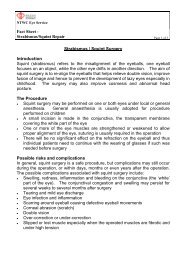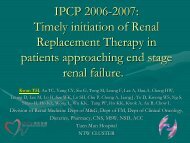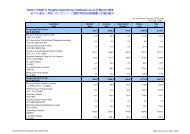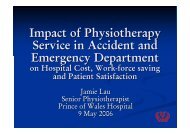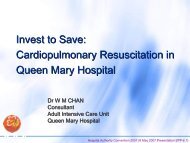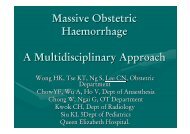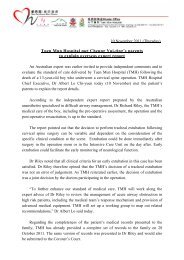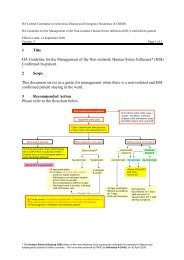Clinical Audits of Emergency Percutaneous Cholecystostomy in ...
Clinical Audits of Emergency Percutaneous Cholecystostomy in ...
Clinical Audits of Emergency Percutaneous Cholecystostomy in ...
- No tags were found...
You also want an ePaper? Increase the reach of your titles
YUMPU automatically turns print PDFs into web optimized ePapers that Google loves.
OverviewRADIOLOGY• Background• <strong>Percutaneous</strong> <strong>Cholecystostomy</strong> (PCC)• Objectives <strong>of</strong> Audit• Results• Discussion
BackgroundRADIOLOGY• Acute cholecystitis• Management• Conservative vs. Operative• Cholecystectomy vs. <strong>Percutaneous</strong> <strong>Cholecystostomy</strong>• Overseas experience• Technical success rate (97-100%)• Effectiveness (90-94%)• Complication rate (3.3-16%)• Local experience• Li JC, Lee DW, Lai CW, Li AC, Chu DW, Chan AC.<strong>Percutaneous</strong> cholecystostomy for the treatment <strong>of</strong> acutecholecystitis <strong>in</strong> the critically ill and elderly. Hong KongMed J. 2004 Dec;10(6):389-93.
<strong>Percutaneous</strong> <strong>Cholecystostomy</strong>(PCC)RADIOLOGYLiverGBChest WallSchematic Diagram <strong>of</strong> PCC
<strong>Percutaneous</strong> <strong>Cholecystostomy</strong>RADIOLOGY• Indications:• Critically ill or elderly patients with calculouscholecystitis• Acute acalculous cholecystitis• Local Anesthesia• Techniques• Transhepatic approach• Transperitoneal approach
CholecystogramRADIOLOGY
<strong>Percutaneous</strong> <strong>Cholecystostomy</strong>RADIOLOGY• Complication:• Bile leakage result<strong>in</strong>g <strong>in</strong> peritonitis• Vagal effect <strong>of</strong> catheter placement (bradycardiaand hypotension)• Hemobilia (usually transient and self-limit<strong>in</strong>g)• Mortality 3-36%
Objectives <strong>of</strong> AuditRADIOLOGY• To assess the cl<strong>in</strong>ical parameters <strong>of</strong> thepatients undergo<strong>in</strong>g percutaneouscholecystostomy.• To evaluate the technical aspects <strong>of</strong>percutaneous cholecystostomy.• To follow up the patients after percutaneouscholecystostomy.
Material & MethodsRADIOLOGY• Retrospective Review• Selection criteria• Data• All patients who underwent PCC from 01.06.2003to 31.05.2005• retrieved from CMS and RIS
Data CollectionRADIOLOGY• Demographics• Age• Gender• Date & time <strong>of</strong> procedure• <strong>Cl<strong>in</strong>ical</strong> parameters• Abdom<strong>in</strong>al pa<strong>in</strong>• Body temperature• Hemodynamic Stability• Bilirub<strong>in</strong> level• WCC• Platelet count• INR• Radiological diagnosis bymodality• Time between radiological examand PCC• Technical parameters• Imag<strong>in</strong>g guidance• Approach• Calibre <strong>of</strong> puncture needle• Use <strong>of</strong> Exchange catheter• Size <strong>of</strong> Fascial dilatros• Dra<strong>in</strong>age catheter used• Anchorage <strong>of</strong> the catheter• Fentanyl usage• Time <strong>of</strong> procedure• Result• Technical result• Bile culture• Death• Time between mortality and PCC• Complication• Blood tests after PCC• Duration <strong>of</strong> hospital stay• Operation (Cholecystectomy)• Time between operation andPCC
DemographicsRADIOLOGY• Total 46 patients (M:F = 22:24)• Mean age = 79.6 years (median = 80.0 years).
<strong>Cl<strong>in</strong>ical</strong> PresentationRADIOLOGYPercentagePa<strong>in</strong>100.0Fever79.3Septic Shock 33.3Elevated WCC78.2Elevated Bilirub<strong>in</strong>58.70 25 50 75 100
Radiological Diagnosis by ModalityRADIOLOGY
Technical Aspects <strong>of</strong> <strong>Percutaneous</strong><strong>Cholecystostomy</strong>RADIOLOGY• All procedures performed under ultrasoundand fluoroscopic guidance• Transhepatic approach - 34 patients (73.9%)• Transperitoneal approach - 6 patients (13.0%)• Time <strong>of</strong> procedure (mean = 27m<strong>in</strong>utes)
ResultsRADIOLOGY• Technically successful PCC <strong>in</strong> 100%• Positive bile culture <strong>in</strong> 32/45 (71.1%)• Rapid cl<strong>in</strong>ical improvement <strong>in</strong> 41/46 patients(89.1%)• Duration <strong>of</strong> hospital stay - 15 days (median)• Elective cholecystectomy performed <strong>in</strong> 11patients (23.9%).
Result - ComplicationRADIOLOGY• Catheter displacement:• 3 patients (6.5%).• 1 Re<strong>in</strong>sertion• 2 Treated conservatively• Time <strong>of</strong> occurence• Between 3 days – 1 week <strong>in</strong> 1patient• > 1 week <strong>in</strong> 2 patients
Result - MortalityRADIOLOGY• Deaths <strong>in</strong> 6 patients (10.5%) and all are not related tothe procedure• Uncontrolled sepsis <strong>in</strong> 2 patients• Patient 1 (M/65)• Refused cholecystectomy• Klebsiella (Resistant to Ampicill<strong>in</strong>, Cefazol<strong>in</strong>, Cefoxit<strong>in</strong>Cefuroxime)• Given Tazoc<strong>in</strong>, Metronidazole• Patient 2 (M/79)• Dissem<strong>in</strong>ated <strong>in</strong>travascular coagulopathy at presentation• Other medical conditions <strong>in</strong> 4 patients
RADIOLOGYDiscussion: ComparisonDiscussion: Comparison28%Median22d20%16%(m<strong>in</strong>or)92%100%25Li90%94%90%89.1%<strong>Cl<strong>in</strong>ical</strong>Response30166546No. <strong>of</strong>Patients90%--3.3%(m<strong>in</strong>or)100%Ito44%-18%18%(1 major)94%Teoh15.3%Mean 15d13.8%No majorones97%Welschbillig23.9%Median15d10.5%6.5%(m<strong>in</strong>or)100%PYNEHElectivecholecystectomyDuration<strong>of</strong> stayDeathsComplicationTechnicalResultAuthors
ConclusionRADIOLOGY• Our results are comparable with overseas and localdata.• <strong>Percutaneous</strong> <strong>Cholecystostomy</strong> is a safe and effectivetreatment <strong>of</strong> acute cholecystitis with high success andlow complication rates.• It can also m<strong>in</strong>imize the morbidity and mortalityrelat<strong>in</strong>g to the complications from emergencyoperation on those critically ill patients, ascholecystectomy can be arranged on an elective basisafter the patient's condition improves.
ReferencesRADIOLOGY• Li JC, Lee DW, Lai CW, Li AC, Chu DW, Chan AC. <strong>Percutaneous</strong>cholecystostomy for the treatment <strong>of</strong> acute cholecystitis <strong>in</strong> the criticallyill and elderly. Hong Kong Med J. 2004 Dec;10(6):389-93.• Welschbillig-Meunier K, Pessaux P, Lebigot J, Lermite E, Aube Ch,Brehant O, Hamy A, Arnaud JP. <strong>Percutaneous</strong> cholecystostomy forhigh-risk patients with acute cholecystitis. Surg Endosc. 2005Sep;19(9):1256-9. Epub 2005 Jul 14.• Teoh WM, Cade RJ, Bant<strong>in</strong>g SW, Mackay S, Hassen AS. <strong>Percutaneous</strong>cholecystostomy <strong>in</strong> the management <strong>of</strong> acute cholecystitis. ANZ J Surg.2005 Jun;75(6):396-8.• Ito K, Fujita N, Noda Y, Kobayashi G, Kimura K, Sugawara T,Horaguchi J. <strong>Percutaneous</strong> cholecystostomy versus gallbladderaspiration for acute cholecystitis: a prospective randomized controlledtrial. AJR Am J Roentgenol. 2004 Jul;183(1):193-6.



